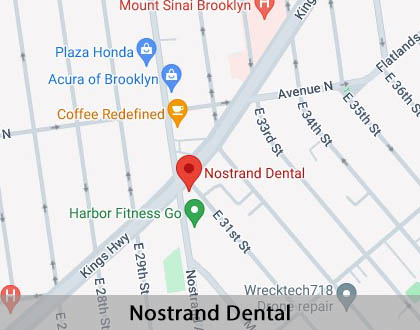Why Dental Sealants Play an Important Part in Protecting Your Child’s Teeth Brooklyn, NY
Dental sealants are one of the leading ways you can protect your child's teeth. This preventative dentistry procedure may potentially save you thousands of dollars in unnecessary dental costs. Dental sealants are quick, easy, and painless.
Dental sealants are available at Nostrand Dental in Brooklyn and the surrounding area. Do not give your child's teeth the chance to decay. Call us today at (718) 513-9685 to schedule an appointment or learn more about our services.
Why Dental Sealants
According to the American Dental Association, brushing and flossing are the "best ways to help prevent cavities." Unfortunately, however, it is not always easy for children to reach certain areas of the mouth. This is especially true when it comes to molars or the back teeth used for chewing.
Due to the molar's location in the mouth and their rough, uneven texture, they are a common gathering place for leftover food and cavity-causing bacteria. Luckily, dental sealants can help. Dental sealants are thin, protective coatings painted on the chewing surfaces of the molars. They are particularly beneficial for children with gaps in between the teeth.
“Due to their location in the mouth and their rough, uneven texture, molars are a common gathering place for leftover food and cavity-causing bacteria.”
Diet and Cavities
Contrary to popular belief, good oral hygiene is not all there is to maintaining a healthy mouth. Diet is also an integral part of one's dental health. Since the body is a series of interrelated systems, anything that affects one's overall health can also affect the health of their teeth and gums.
In particular, excessive sugar consumption can put one at risk for tooth decay, the leading preventable chronic childhood disease. This disease may occur when plaque comes into contact with sugar in the mouth. It is also essential for patients to eat a balanced diet. A diet lacking in certain nutrients may make the tissues in the mouth more vulnerable to infection and contribute to gum disease.
“Since the body is a series of interrelated systems, anything that affects one’s overall health can also affect the health of their teeth and gums.”
Busy Schedules and Dental Hygiene
When it comes to maintaining one's oral health, keeping a consistent dental hygiene routine is paramount. However, it is not uncommon for busy schedules to get in the way of flossing or brushing. This is especially true for forgetful children, who are at heightened risk for tooth decay.
While tooth decay (also known as cavities) are a common issue for patients of all ages, untreated cavities can cause a variety of problems in children, including:
- Difficulty concentrating on learning
- Pain
- Problems affecting overall quality of life and ability to succeed
- School absences
Dental sealants can help provide extra protection for areas particularly vulnerable to decay, even when children forget to brush and floss.
“Dental sealants can help provide extra protection for areas particularly vulnerable to decay, even when children forget to brush and floss.”
Check out what others are saying about our dental services on Yelp: Why Dental Sealants Play an Important Part in Protecting Your Child's Teeth in Brooklyn, NY
The Difference Dental Sealants Make
As stated by the American Dental Association, dental sealants have been proven to reduce a child's risk of tooth decay in the molars by almost 80%. Plus, a 2016 report published by the Centers for Disease Control and Prevention (CDC) revealed that "school-age children without sealants have almost three times more cavities than children with sealants."
Dental sealants often last for several years before needing to be reapplied. Nostrand Dental can check the condition of the dental sealant during a regular checkup and reapply them as needed. As such, patients can think of them as a worthy investment to make in their dental health.
“Dental sealants also often last for several years before needing to be reapplied.”
Questions Answered on This Page
Q. How can my child benefit from dental sealants?
Q. What foods can cause cavities?
Q. How can dental sealants supplement a good oral hygiene routine?
Q. What difference do dental sealants make?
Q. How can dental sealants help save me money?
People Also Ask
Q. How can a person's diet help with tooth decay?
Q. How often should someone have a dental checkup?
Q. What's the right age to get sealants?
Q. What services are offered by a general dentist?
Prevention vs. Reaction
Dental sealants are one of the most popular preventative dentistry treatments available on the market. According to a recent report published by the Centers for Disease Control and Prevention (CDC), the painless procedure prevents 80% of cavities for two years after application and protects against 50% of cavities for up to four years. They can also remain in the mouth for as long as nine years.
By preventing decay, dental sealants also effectively prevent the patient from undergoing any unnecessary, costly procedures. In fact, the CDC report found that applying sealants to approximately seven million children from low-income households could save up to a total of $300 million in dental treatment costs.
“By preventing decay, dental sealants also effectively prevent the patient from undergoing any unnecessary, costly procedures.”
Frequently Asked Questions
Q. What makes dental sealants better than fillings?
A. Some parents balk at the upfront cost of dental sealants, deciding it would be a better choice to pay for their children's dental fillings as necessary. However, tooth decay comes with permanent damage that weakens the teeth. It also makes the teeth more susceptible to further damage. Dental sealants can help protect the teeth's natural coating.
Q. Can dental sealants replace fluoride treatments?
A. No. Dental sealants work best in conjunction with fluoride treatments, as they cannot promote tooth remineralization the way fluoride does. Together, the two can strengthen the teeth against decay.
Q. What is a dental cavity?
A. Cavities, or dental decay, are permanent holes in the teeth. If left untreated, cavities can grow larger and become infected. They occur most often in the grooves of the back teeth.
Q. What do dental sealants look like?
A. Dental sealants typically cannot be seen when your child is talking or smiling. They may be white, clear, or slightly tinted. In any case, they are designed to be discreet.
Q. When is the best time for my child to get dental sealants?
A. Dental sealants are the most effective when applied soon after permanent molars have emerged. For most children, this occurs around age six for the first molars and age 12 for the second set.
Family Dental Terminology
Call Us Today
Sealants can reduce your child's lifetime risk of cavities. Dental sealants offer a peace of mind for busy parents and help prevent future dental problems for their children. Let Nostrand Dental in Brooklyn help you explore the benefits of dental sealants. Call us at 718-513-9685 to schedule an appointment with a qualified dentist.
Helpful Related Links
- American Dental Association (ADA). Glossary of Dental Clinical Terms. 2024
- American Academy of Cosmetic Dentistry® (AACD). Home Page. 2024
- WebMD. WebMD’s Oral Care Guide. 2024
About our business, license, and website security
- Nostrand Dental was established in 1998.
- We accept the following payment methods: Cash, CareCredit, Check, Discover, MasterCard, and Visa
- We serve patients from the following counties: Kings County, New York County, Richmond County, Queens County, and Nassau County
- We serve patients from the following cities: Brooklyn, Manhattan, Queens, Staten Island, and Long Island
- NY (License #46702). View License Information and Specifics
- National Provider Identifier Database (1457434540). View NPI Registry Information
- Norton Safe Web. View Details
- Trend Micro Site Safety Center. View Details
Back to top of Why Dental Sealants Play an Important Part in Protecting Your Child's Teeth
QR code for Why Dental Sealants Play an Important Part in Protecting Your Child's Teeth











